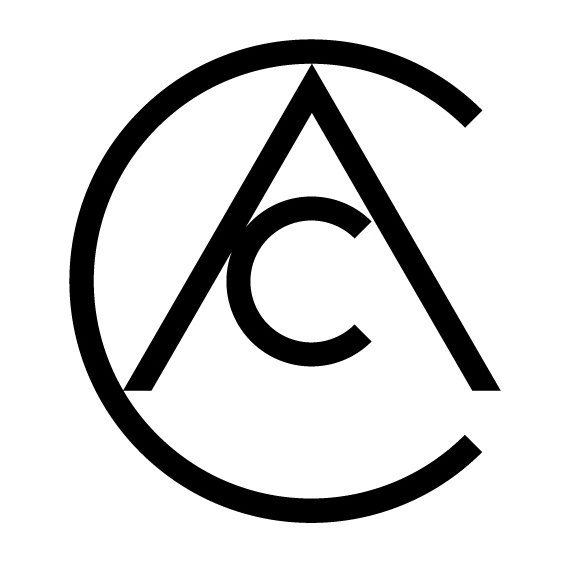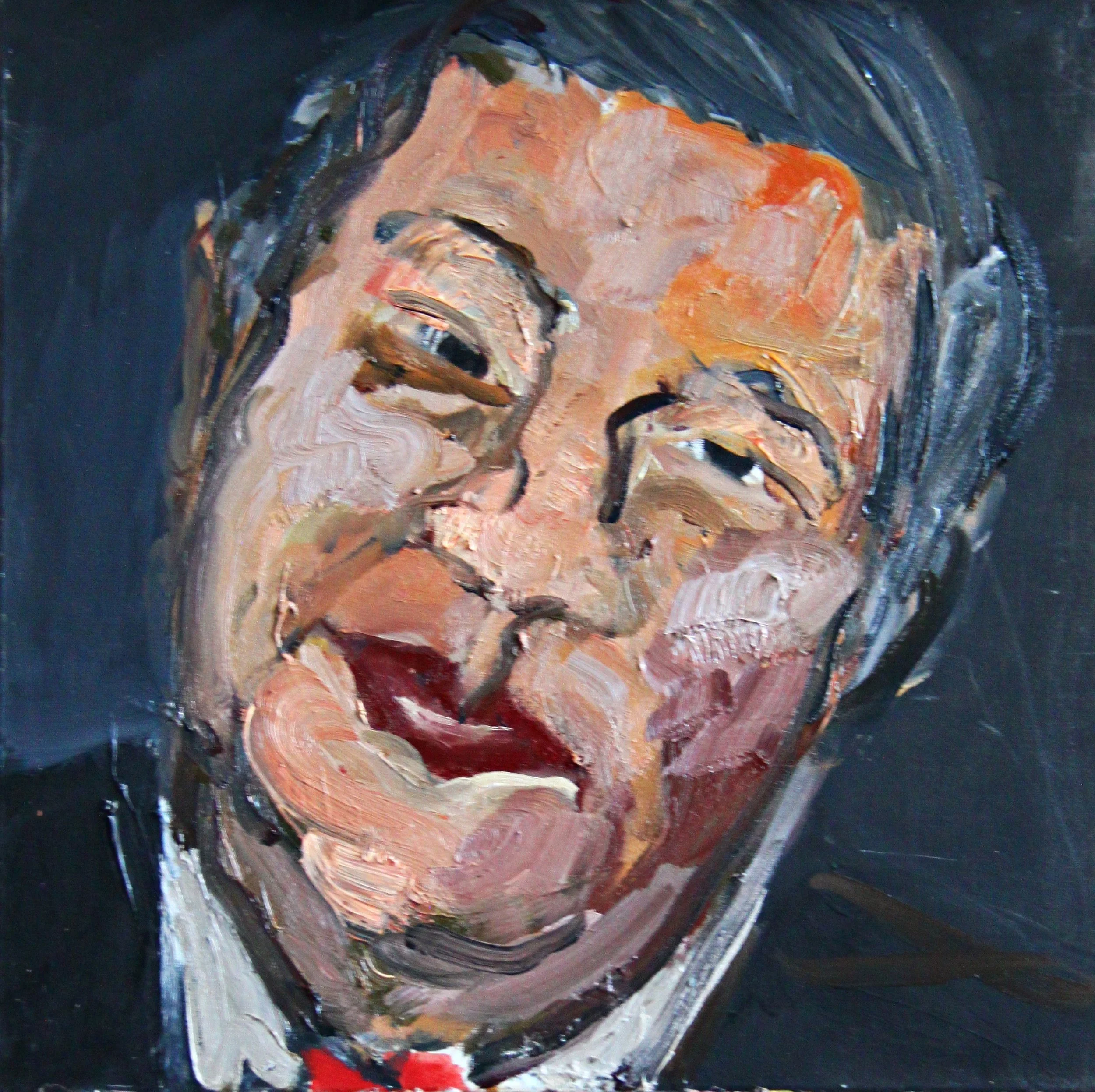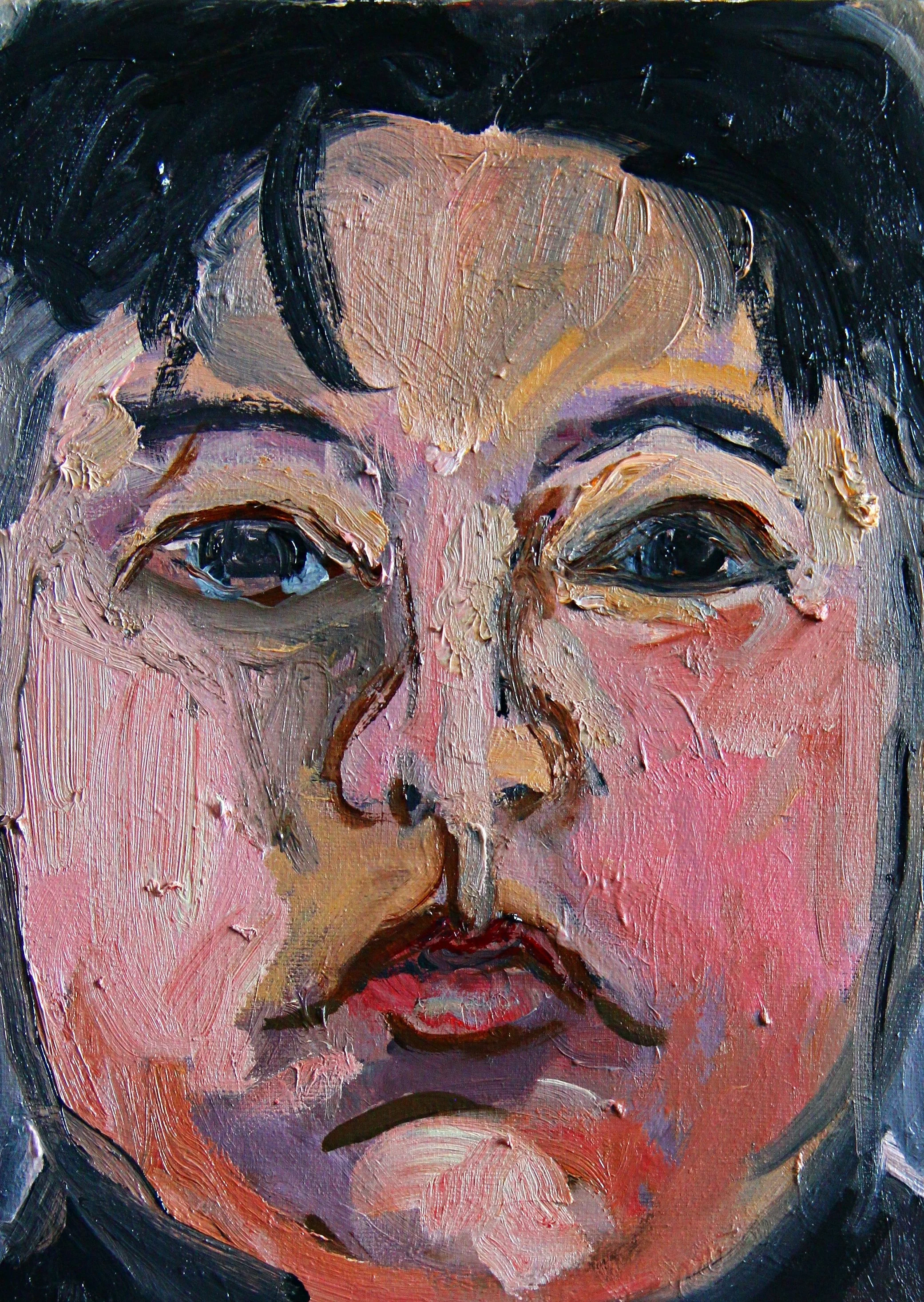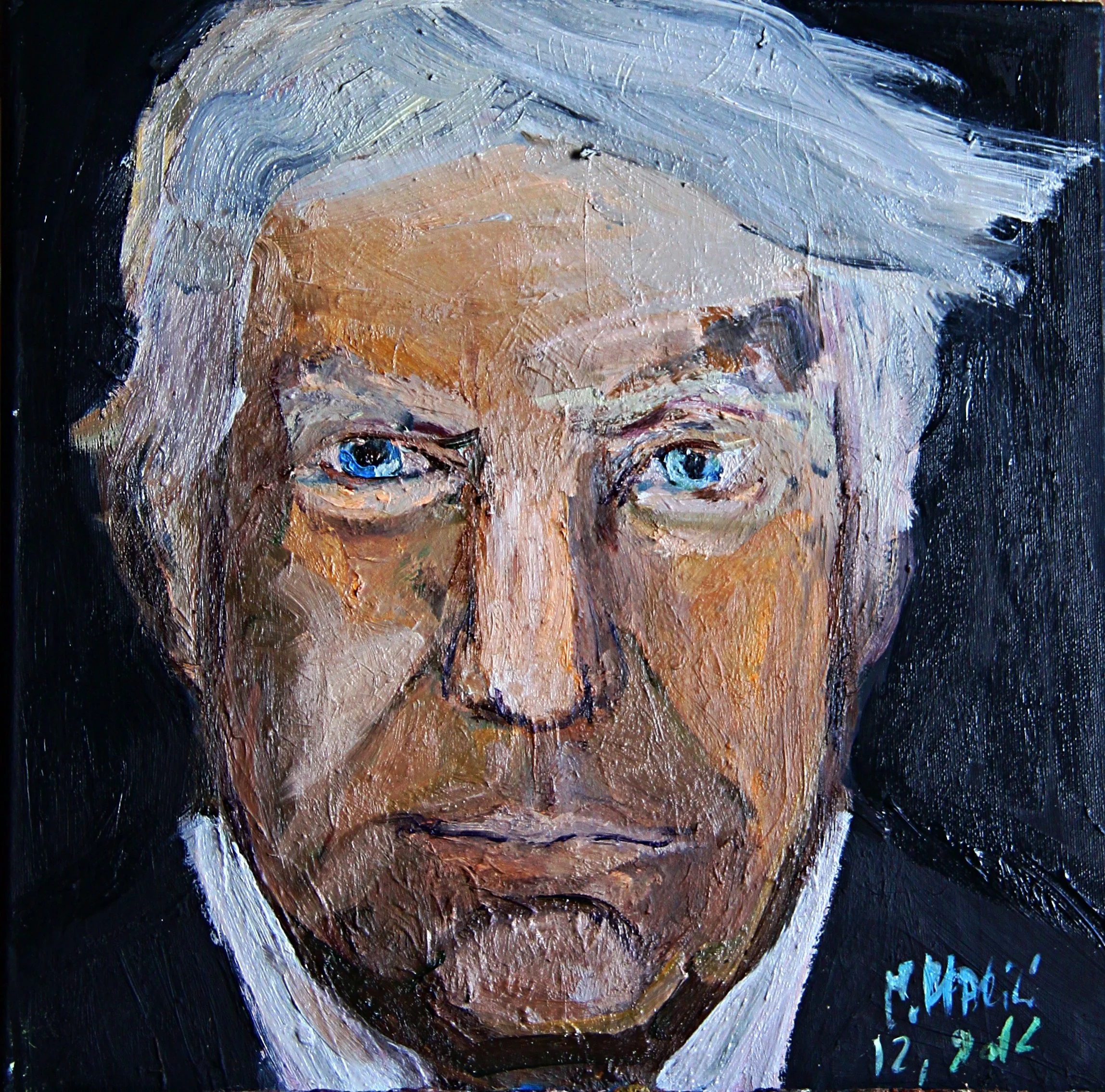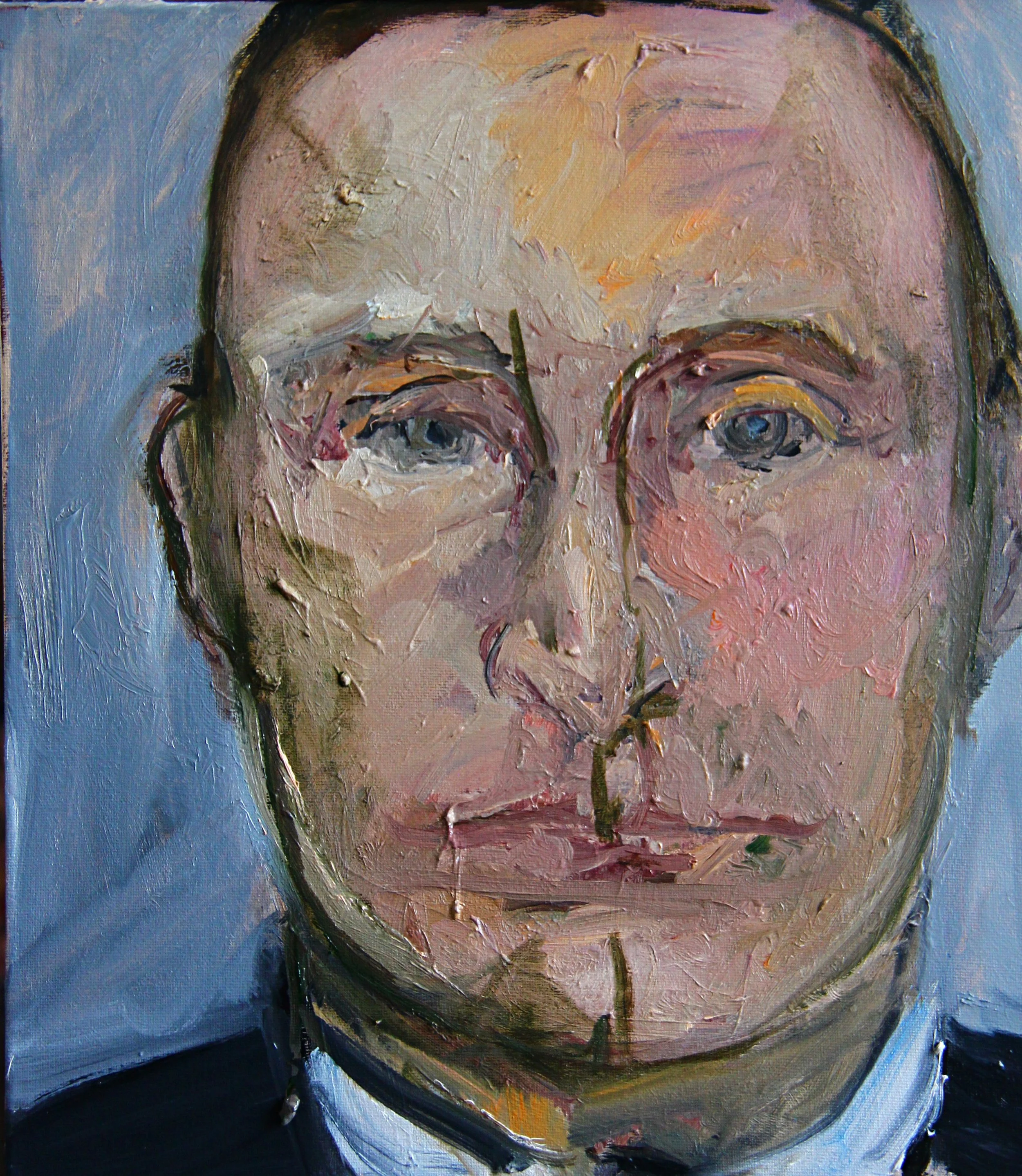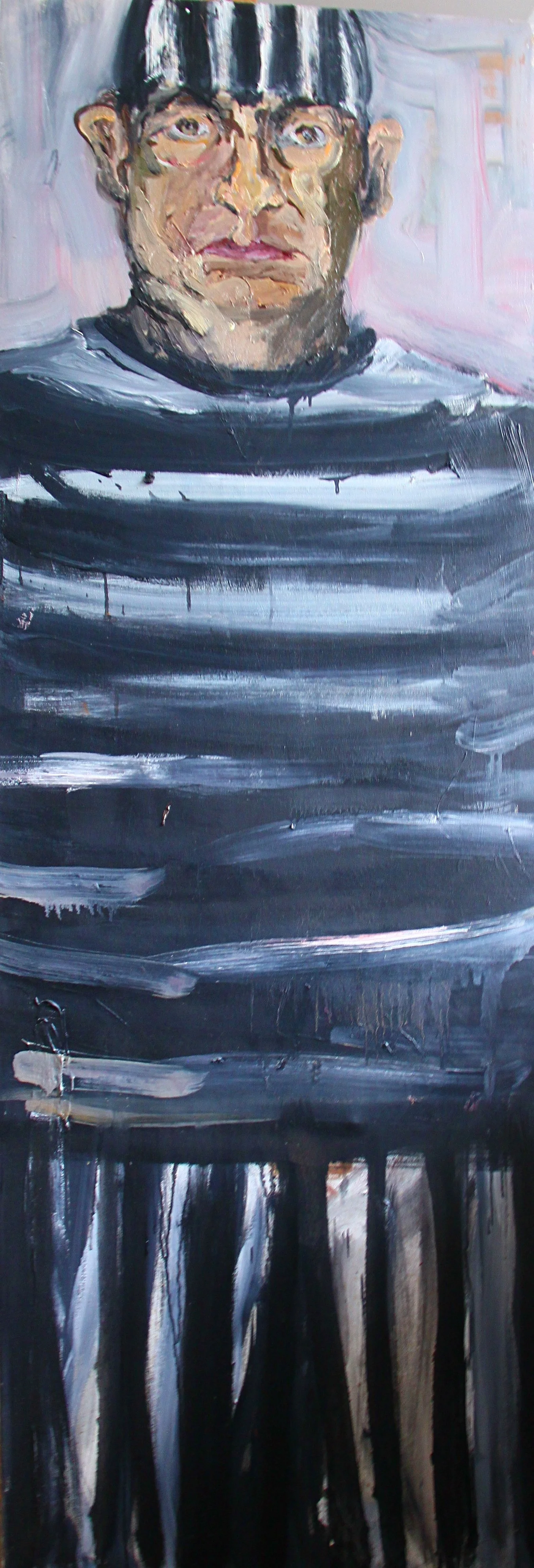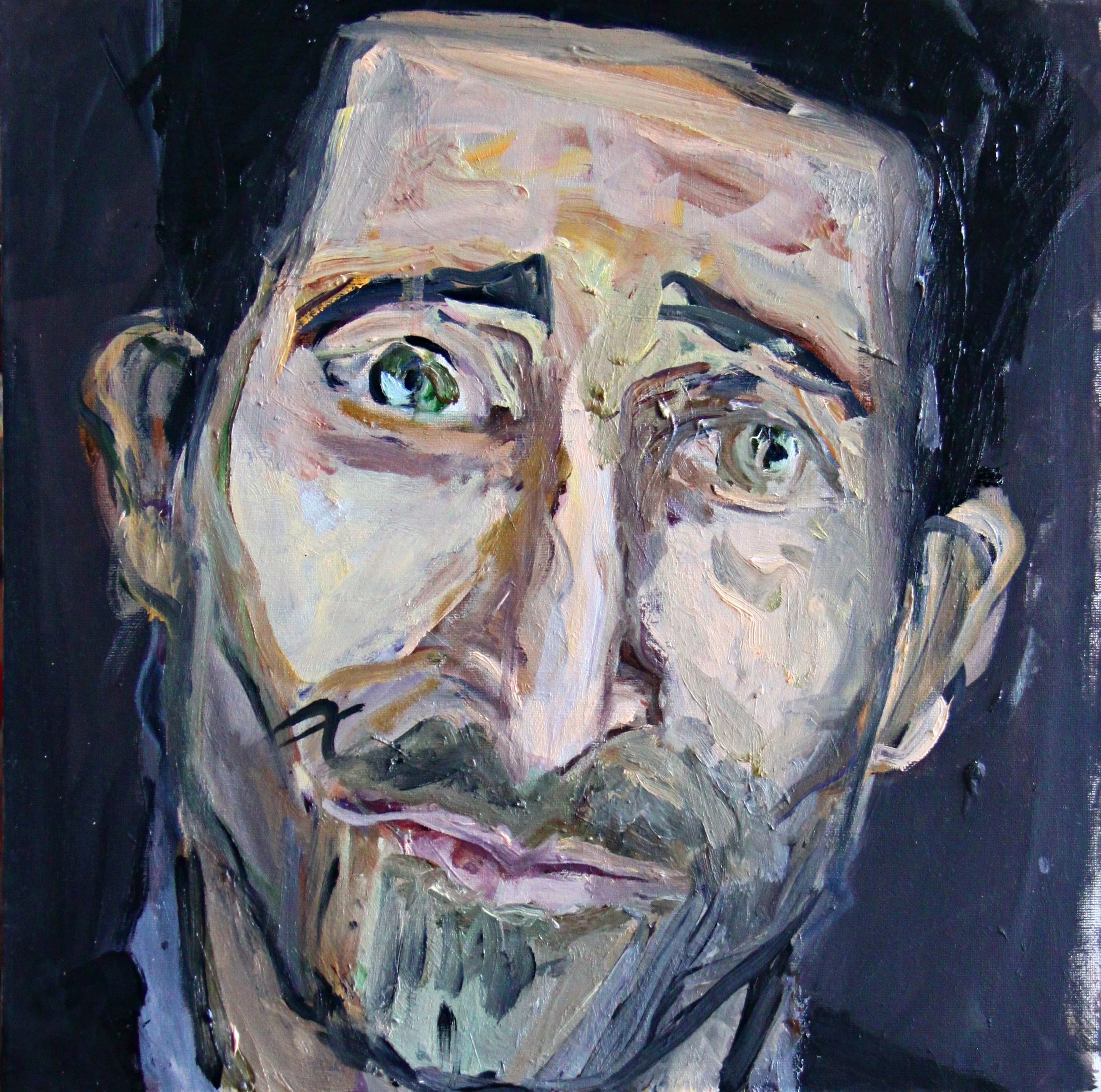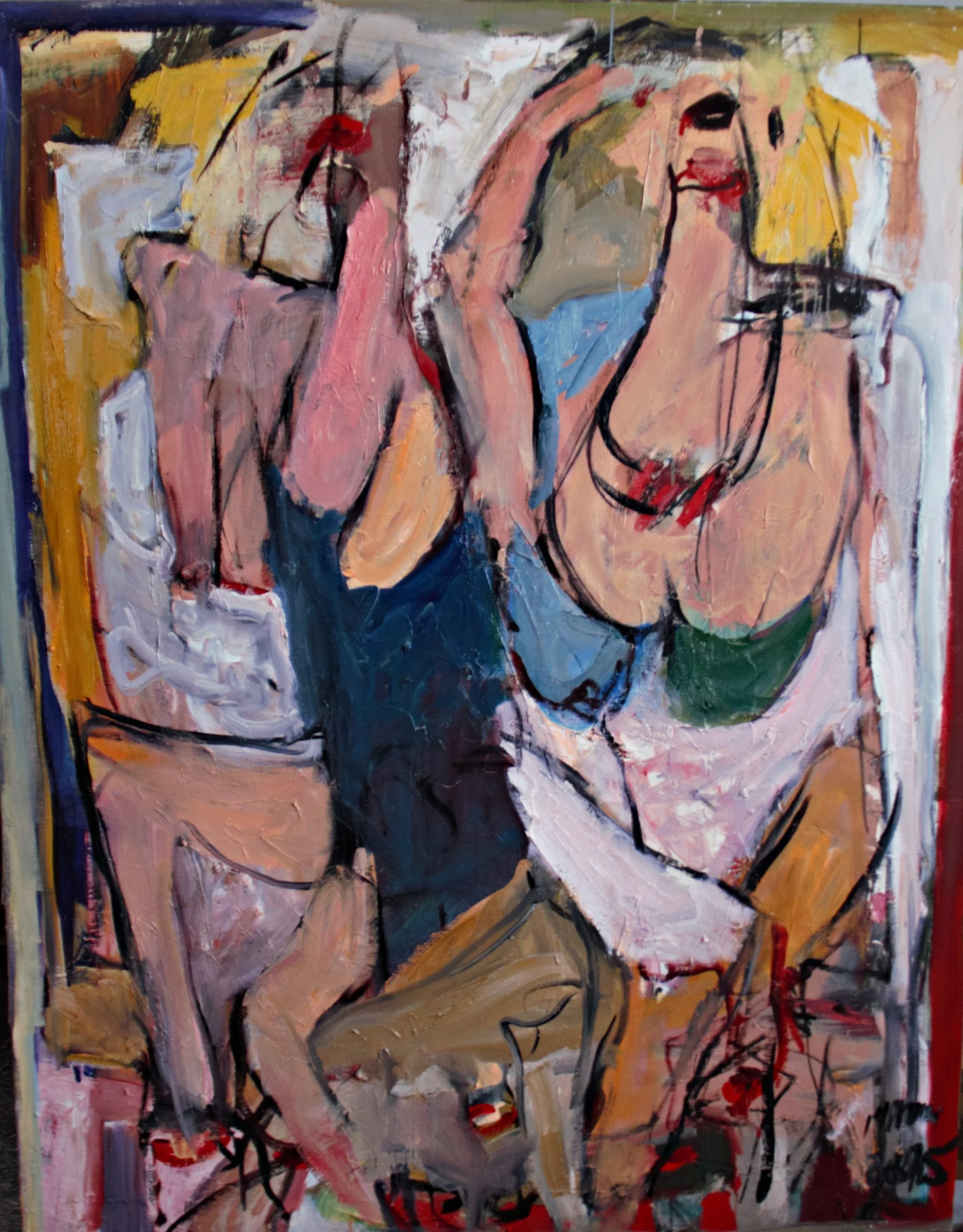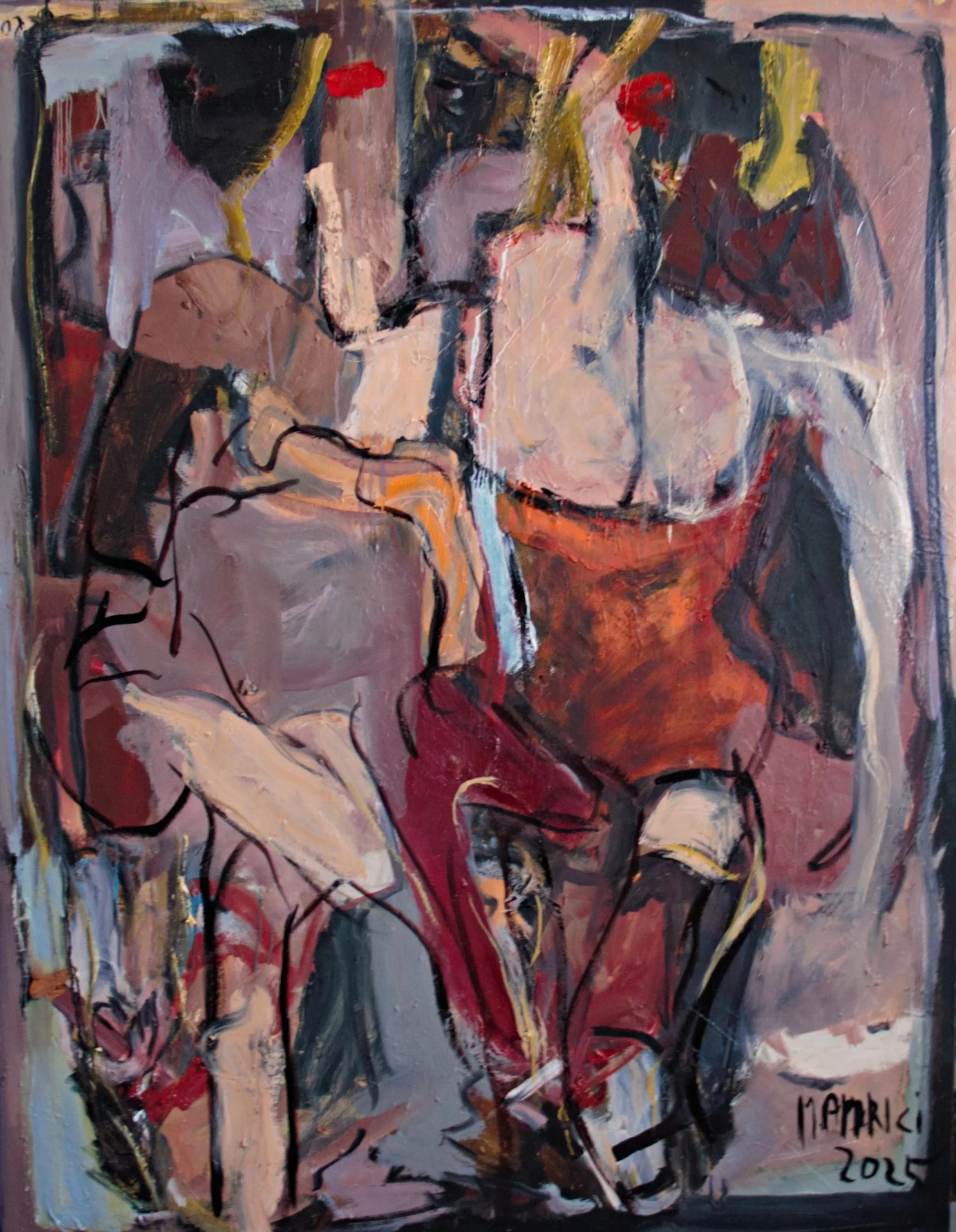Maria Aparici
To enter the world of Maria Aparici is to confront painting at its most volatile threshold, where figuration disintegrates under the weight of conscience, and color, rather than adorning the visible, becomes an indictment of what society has refused to see. Born in Valencia in 1952, Aparici’s trajectory from the rigorous classical training of the School of Applied Arts in Burgos to her immersion in New York’s experimental modernism at the New School for Social Research, and ultimately to the mature reflection of her Madrid studio, charts the evolution of a painter who has never been content with form as mere representation. In Aparici’s canvases, form is revolt, an act of radical unveiling against the history that has made women’s visibility contingent upon their compliance.
Her oeuvre unfurls as a confrontation between matter and ideology, brushstroke and myth. Across her portraits and figural compositions, whether in the impastoed, confrontational faces of global power figures or in the fractured, dissonant anatomies of women who dance between ridicule and resistance, Aparici articulates a visual vocabulary of ambiguity, distortion, and psychological tension. The act of painting, for her, is not aesthetic pleasure but exorcism: a process of reclaiming a space from which women have been exiled.
Consider Netanyahu (2024), where the thickly layered surface carries the physical weight of paint as accusation. The figure stands upright, monumental and yet grotesque, striped like a prisoner in his own authority. The strokes are rough, urgent, trembling between abstraction and corporeal insistence. The black and white bands dissolve downward into fluid streams, as if history itself were melting. There is no clear boundary between the man and his backdrop, between politics and the anonymous materiality of power. Aparici turns portraiture into confrontation; her paint refuses decorum.
This refusal continues in Trump (2025), where the sculptural density of oil captures not the likeness but the anatomy of hubris. The eyes—icy, overexposed glimmer not with insight but with the hollowness of performative power. The flesh is built from layers of ochre, gray, and violet, recalling the tradition of European expressionism but shattering its male gaze. Aparici’s brush transforms flesh into terrain: uneven, wounded, trembling with contradictions.
Her Xi Jinping (2025) and Putin (2024) follow this same visceral logic. Their faces, distorted yet instantly recognizable, are rendered not as individuals but as embodiments of moral decay. Thick, tactile brushwork transforms skin into armor, while the space surrounding their faces presses forward like an invisible regime. Aparici’s portraits of male power figures are not caricatures; they are psychoanalytic excavations. Each impasto layer functions as a sediment of denial, a record of collective blindness. In this sense, her painting operates at the intersection of moral testimony and painterly experimentation.
The influence of expressionism is palpable, yet Aparici’s distortion diverges sharply from that of her male predecessors. Her language of deformation is not a symptom of nihilism but an ethical stance. Where Otto Dix sought to reveal the grotesque as the horror of postwar existence, Aparici deploys the grotesque as a feminist intervention—an inversion of the canon that ridiculed women while sanctifying men. Her distortions do not annihilate the figure; they dignify it through defiance. She reclaims ugliness as authenticity, absurdity as truth.
In her female nudes—Las Reinas de las Fiestas Papachinas (2025), Wedding Girls (2025), The Painting and Me (2025)—the act of distortion becomes redemptive. The bodies are elongated, fragmented, and rendered with gestures that oscillate between eroticism and disillusion. There is an unmistakable violence in the way the paint is applied: thick, raw, dripping with emotion. Yet, paradoxically, this violence unveils tenderness. Aparici’s women are not muses but martyrs of their own visibility. Their faces blur into anonymity, their limbs exaggerated beyond proportion, as if the body itself were rebelling against centuries of objectification.
In Las Reinas de las Fiestas Papachinas, two female figures occupy the frame in a chaotic choreography of color and tension. Their bodies, fractured and overlapping, seem caught between ecstasy and exhaustion. The surrounding hues—pink, ochre, crimson, lavender—vibrate with both pleasure and warning. The figures appear to perform femininity while simultaneously dismantling it. This double gesture, both embodiment and resistance, is central to Aparici’s vision. Her women are grotesque because they refuse to be ornamental; they are distorted because history has already distorted them.
Wedding Girls continues this exploration of feminine absurdity and despair. The palette of dense pinks, fleshy oranges, and shadowed violets evokes both celebration and mourning. The two figures, their features erased into expressive blur, seem trapped within the ritual of their own undoing. Aparici’s line is restless, her brushwork nervous, tracing the boundaries between costume and skin, laughter and pain. The women are neither brides nor victims; they are theatrical archetypes of a civilization addicted to spectacle.
In The Painting and Me, Aparici turns her gaze inward, fusing self-portraiture with metaphysical reflection. The solitary female figure, loosely structured yet commanding the entire canvas, sits with a complex blend of defiance and vulnerability. Her red dress bleeds into the surrounding field of ochres and greens, suggesting both presence and dissolution. Here, painting becomes a confession, the material extension of a consciousness grappling with its own contradictions. The woman appears both alive and effaced, an emblem of artistic struggle and existential doubt.
Aparici’s figurative language derives its strength from contradiction. She moves effortlessly between abstraction and figuration, between lyrical gesture and brutal mark-making. Her surfaces are never stable; they breathe, tremble, and resist closure. The visible brushstroke is not a stylistic affectation but a declaration of subjectivity. It asserts the presence of the artist’s body, her labor, her anger. The impasto carries emotional memory; each mark is an imprint of lived resistance.
Her portraits of well-known men, juxtaposed against her anonymous women, reveal a dialectic between authority and vulnerability, domination and irony. The men are immobilized by their own importance, their features fossilized into masks of power. The women, by contrast, are alive in their disintegration fluid, unstable, uncontainable. Aparici’s feminist critique operates precisely through this inversion. She renders male power grotesque through rigidity, and female resistance sublime through distortion.
The grotesque, for Aparici, is not an aesthetic category but an ethical one. It is her tool of truth-telling. By exaggerating features, she refuses idealization; by thickening pigment, she refuses transparency. Her work destabilizes the patriarchal hierarchy that has long equated beauty with virtue, ugliness with vice. The grotesque becomes a mirror in which society must confront its own moral deformity.
What emerges from this tension is a kind of tragic expressionism. Aparici’s palette, though often dominated by earthy flesh tones and violent reds, contains moments of surprising luminosity, hints of pale blue, lavender, ochre, and peach that recall the Mediterranean light of her native Valencia. Yet, these moments never soften the emotional gravity of her compositions; they only sharpen the paradox of beauty born from pain.
Her connection to her grand-uncle, Manuel Benedito Vives, provides a fascinating historical counterpoint. Where Benedito’s classical realism sought order and restraint, Aparici’s expressionism is a rebellion against that very discipline. Her inheritance is not stylistic but psychological; she reinterprets his mastery of portraiture through the lens of existential crisis. In her hands, the portrait ceases to be a mirror of likeness and becomes a battlefield of identities.
The ghosts of the twentieth century—war, patriarchy, spectacle haunt Aparici’s paintings, yet her vision is insistently contemporary. She sees in today’s culture a continuation of the archaic. “There is a new and old specimen of a vase woman,” she declares, “without ethics and even less aesthetics.” This figure, half-muse and half-commodity, becomes her recurring subject: the woman as a mirror of a civilization that continues to disguise exploitation as glamour. Her refusal to idealize these women is her protest against a system that rewards docility.
Her disdain for Spain’s “hard and aggressive archaic sector,” her rejection of bullfighting and tradition, is not simply political; it is aesthetic. The same machismo that glorifies violence, she implies, corrupts beauty. Her art is the inverse of spectacle: a moral painting that exposes, rather than seduces. To paint against tradition in Spain is to paint against a national unconscious. Aparici’s courage lies in doing precisely that.
One senses, in her handling of paint, the legacy of New York’s gestural abstraction, but tempered by the European consciousness of tragedy. Her brushstrokes are both spontaneous and deliberate, carrying the immediacy of action painting yet structured by the emotional density of expressionism. She paints not from observation but from necessity. As she has said, “I launch myself directly to the canvas… like someone who jumps into space.” This leap is not stylistic bravado; it is faith in painting as existential truth.
Her figures, whether grotesque or sublime, oscillate between collapse and emergence. They seem to disintegrate and reconstitute before our eyes, suggesting that identity itself is a process of perpetual becoming. In this way, Aparici’s work transcends feminism as ideology and reaches toward universality. Her art exposes the fragility of all human constructs, gender, power, and history, and insists on the authenticity of emotion as the last uncorrupted territory.
To view her paintings collectively is to witness a visual symphony of revolt: a chorus of voices long suppressed, speaking through distortion, color, and texture. Aparici transforms the canvas into a space of ethical urgency, where beauty and horror coexist, and where the viewer becomes complicit in the act of seeing. Her work does not ask for admiration; it demands recognition.
In the context of contemporary art, where irony often replaces conviction, Aparici’s sincerity feels radical. She stands apart from conceptual trends that favor detachment. Instead, her practice insists on the return of the hand, the body, and the wound. She reasserts painting as a medium of moral inquiry. In an age obsessed with surface, she offers depth; in a culture that rewards conformity, she paints disobedience.
Her international trajectory spanning exhibitions in Davos, Cincinnati, New York, Madrid, Barcelona, Milan, and Rome reflects not a pursuit of fame but the migration of conscience. Wherever she shows, her paintings provoke the same response: discomfort mixed with admiration, unease that leads to reflection. She has received numerous honors—the Botticelli, Michelangelo, and Frida Kahlo Prizes, among others, but her true achievement lies in the persistence of her vision.
If one were to locate Aparici’s place within art history, it would be alongside those who transformed suffering into revelation. She paints like someone who knows that redemption is not guaranteed, but still necessary. Her women, though grotesque, are not broken; they are witnesses. Her men, though powerful, are not sovereign; they are exposed.
In her mature work, the boundaries between the personal and the political collapse entirely. Each painting becomes an allegory of endurance. The surface scarred, luminous, unfinished mirrors the human condition. Aparici paints the absurdity of existence with the gravity of one who has lived it.
Ultimately, Maria Aparici’s art is a theology of resistance. She believes, against all evidence, in the power of paint to unveil the truth. Her distortions are acts of faith; her grotesques are forms of love. Through them, she redefines beauty as honesty and transforms ugliness into the language of awakening.
In the contemporary landscape, dominated by irony, spectacle, and marketable aesthetics, Aparici’s paintings stand as counter-monuments to sincerity. They remind us that art, at its core, is an ethical gesture, a way of affirming humanity in the face of its own contradictions. Her canvases are mirrors that do not flatter but reveal, wounds that do not heal but illuminate.
In this, she joins the lineage of artists who have refused to separate art from conscience. Her legacy will not be one of decoration but of revelation. Through her fierce brushwork, her grotesque archetypes, and her unyielding defense of women’s dignity, Maria Aparici has forged a visual language that confronts the world’s deformities with compassion and courage.
To stand before her paintings is to feel the pulse of resistance thick, rhythmic, and alive beneath the surface of color. It is to realize that the grotesque, in her hands, is not the opposite of beauty but its last, defiant form.
Maria Aparici’s oeuvre invites us not merely to look but to undergo an experience, a confrontation with the layers of truth that painting, when honest, can still uncover. Her canvases remind us that painting remains one of the few languages capable of resisting the anesthetizing effects of modern life. In a cultural moment obsessed with surface, Aparici’s work insists on depth; in a world that celebrates speed, she slows vision down to the viscosity of oil paint. Each brushstroke seems to demand accountability not only from the viewer but from the history that shaped our eyes.
Her art does not offer comfort, nor does it conform to aesthetic decorum. Instead, it forces us to rethink the meaning of form itself: to see that distortion can be revelation, that ugliness can be a site of dignity, and that the grotesque is the soul’s revolt against silence. The bodies she paints, often twisted or doubled, suggest that identity itself is a field of struggle. The viewer, drawn into their turbulence, becomes a participant in the process of redefinition. This is what gives Aparici’s art its lasting force, its refusal to let the viewer remain passive.
As one of the most intellectually and emotionally authentic voices of her generation, Aparici repositions painting as an instrument of consciousness. Her canvases are moral documents as much as visual works: they testify to the persistence of humanity in the face of erasure. By reclaiming the female body from objectification and transforming it into a vessel of thought and resistance, she continues the unfinished work of rewriting art history from within.
Her contribution lies not in perfecting form but in liberating it. Each painting is an act of emancipation from patriarchal ideals, from aesthetic hypocrisy, and from the complacency of beauty without truth. Through her art, Maria Aparici reminds us that to paint is to insist that meaning still matters, and that even in distortion, there is clarity; in rage, tenderness; and in resistance, an enduring grace.
By Marta Puig
Editor Contemporary Art Curator Magazine
Xi Jinping, 2025, O/C , 40 x 40 cm
Kim Jong-Un, O/C, 33x 24 cm ,2025
Trump , O/C, 40 x 40 cm , 2025
Putin , O/C , 40 x 40 cm , 2024
Netanyahu , O/C ,175 x 60 cm . 2024
Adrian Brody, O/C , 40 x 40 cm 2025
El Huevo Frito , O/C , 180 x 106 cm 1998
Las REinas de las Fiestas Papachinas, O/C, 146 x 114 cm , 2025
Wedding Girls , O/C , 146 x 114 cm , 2025
THe Painting and Me, O/C , 146 x 114 cm , 2025
